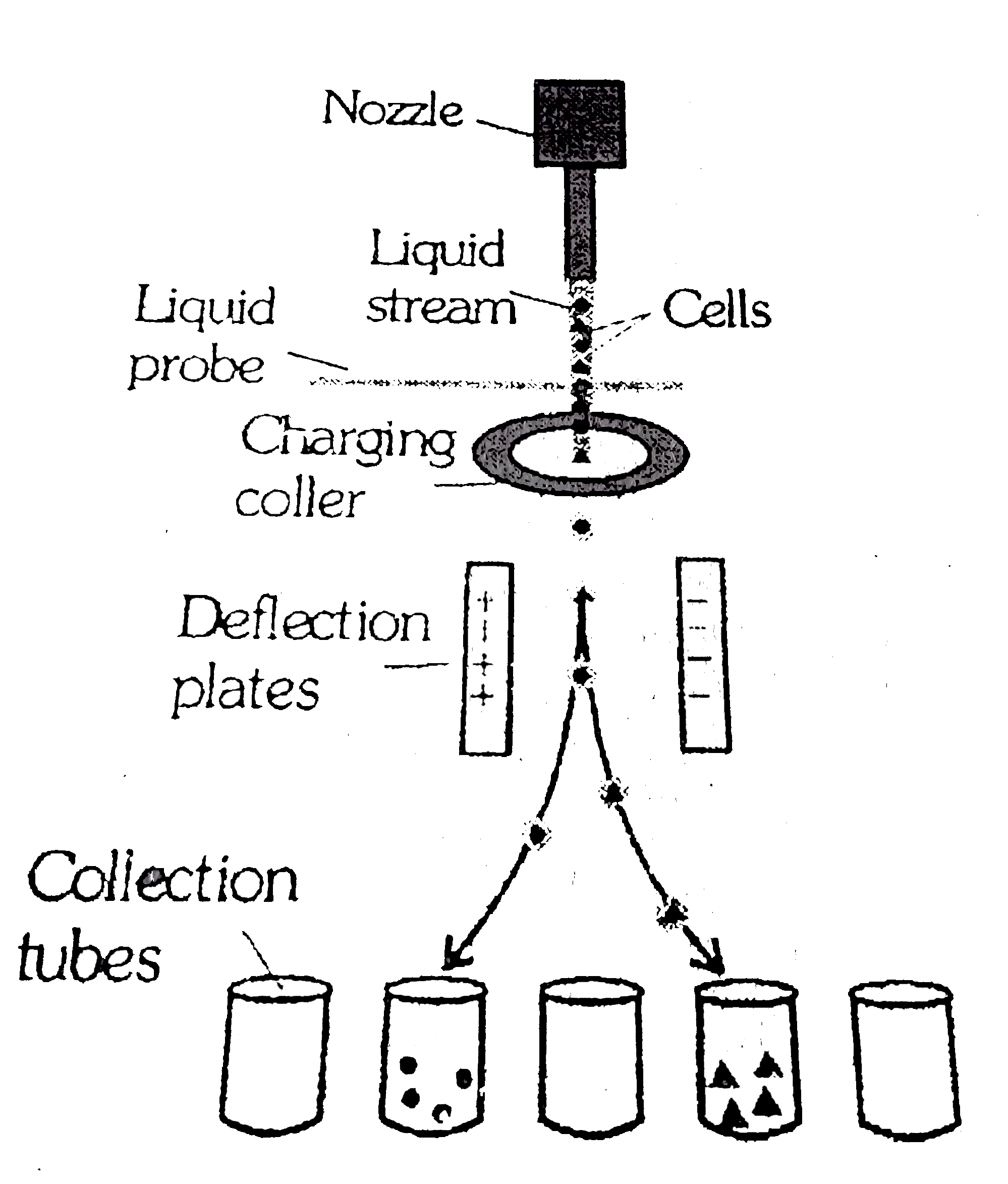Flow cytometry, illustrated in the figure, is a technique used to sort cells by type. The cells are placed in a conducting saline solution which is then forced from a nozzle. The stream breaks up into small droplets, each containing one cell. A metal collar surrounds the stream right at the point where the droplets seprate from the stream. Charging the collar polarizes the conducting liquid, causing the droplets to become charged as they break off from the steam. A leser beam probes the solution just upstream from the charging collar, looking for the presence of certain types of cells. All droplets containing one particular type of cell are given the same charge by the charging collar. Droplets with other desired types of cells receive a different charge, and droplats with no desired cell receive no charge. The charged. The charges droplets then pass between two parallel charged electrodes where they receive a horizontal force that directs force that directs them into different collection tubes, depending on air charge.

Another way to sort the droplets would be to given each droplet the same charge, then vary the electric field between the deflection plates. For the apparatus as sketched, this technique will not work because
Several droplets are between the plates at one time, and they would all feel the same force.
The cells in the solution have net charges that would affect the droplet charge.
A droplet with a net charge would always experience a net force between the plates.
A droplet with a net charge would not always experience a net force between the plates.
The correct Answer is:A
Concept based
Topper's Solved these Questions
- MISCELLANEOUSBOOK - ALLENCHAPTER - MISCELLANEOUSEXERCISE - Exersice-04[A]
34 Videos
- MISCELLANEOUSBOOK - ALLENCHAPTER - MISCELLANEOUSEXERCISE - Exersice-04[B]
16 Videos
- MISCELLANEOUSBOOK - ALLENCHAPTER - MISCELLANEOUSEXERCISE - Comprehension 8
4 Videos
- KINEMATICS (MOTION ALONG A STRAIGHT LINE AND MOTION IN A PLANE)BOOK - ALLENCHAPTER - KINEMATICS (MOTION ALONG A STRAIGHT LINE AND MOTION IN A PLANE)EXERCISE - BEGINNER S BOX-7
8 Videos
- PHYSICAL WORLD, UNITS AND DIMENSIONS & ERRORS IN MEASUREMENT BOOK - ALLENCHAPTER - PHYSICAL WORLD, UNITS AND DIMENSIONS & ERRORS IN MEASUREMENT EXERCISE - EXERCISE-IV
8 Videos
Similar Questions
Knowledge Check
Collar cells are found in
ACtenophoraBCoelentrataCPoriferaDEchinodermataTwo water droplets merge with each other to from a larger droplet. In this proces
Aenergy is liberatedBenergy is absorbedCenergy is neither liberted nor absorbedDsome mass is converted into energyCollar cells occur in
ASpongesBHydraCSandwormDStar fish
Which of the following cells contain fat droplets ?
View SolutionA conducting liquid bubble of radius a and thickness t(t<<a) is charged to potential V. If the bubble collapses to a droplet , find the potential on the droplet .
View SolutionN small conducting liquid droplets, each of radius r, are charged to a potential V each. These droplets coalesce to form a single large drop without any charge leakage. Find the potential of the large drop.
View SolutionA drop of mercury has some charge. If it breaks up into a number of indentifal droplets, the electrostatic energy of the system will
View SolutionWhich of the following cells contain fat droplets ?
View Solution
